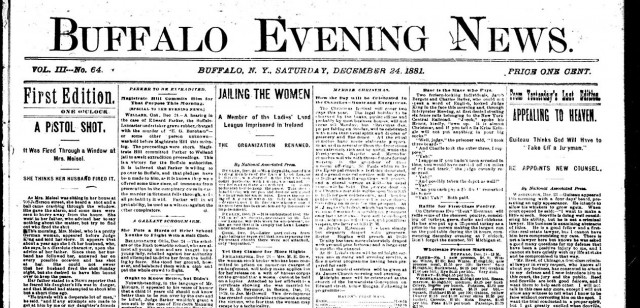Buffalo in the late 1970’s may have been a town down on its luck, but for newspaper publishers it had one major virtue: a great deal of stability in the population – people born and bred in Buffalo were loyal to the place, and its institutions, such as its historic newspapers.

Another virtue, for an afternoon paper producer, was the industrial nature of the town where many people got to work early and then read their papers in the late afternoon or evening; these blue-collar workers had developed a habit of reading the News. In terms of being bought by a high percentage of households in its area it led the pack of big US cities.
Charlie Munger pointed to another factor giving the News an advantage in his 1977 letter to shareholders accompanying Blue Chip Stamps Annual Report – its reputation for high quality journalism:
“Our investment decision was based on the belief that the existing journalistic merit of the News, encouraged and nourished, will eventually prosper in the marketplace and that inflation will eventually make a prosperous newspaper company a safer asset than any other company which we could then buy at the price paid for the News. Experience and reconsideration have made us more confident than ever that we were right in our original appraisal of the journalistic merit of the News. The News is a meritorious newspaper partly because it was dominated and molded for decades by a legendary editor, Alfred Kirchhofer, who, although retired, still comes to the News every day at age 83. Mr. Kirchhofer had and has a passion for accuracy, fairness and service. Present management had continued these standards before our purchase, and we have encouraged their perpetuation.”
Its high reputation meant that the News was able to outsell the Courier-Express during the week – with Monday to Friday circulation of 270,000 compared with 125,000.
Room for improvement
But, as the chairman of Blue Chip Stamps went on to write in his letter, there were “problems and uncertainties inherent in this sort of newspaper investment”. He expressed frustration that when they took over the News the competing Courier-Express published seven days a week, but for over 60 years the News had only published on six days. The Courier-Express, with its comfortable monopoly, was selling 275,000 on a typical Sunday; the day for which advertisers paid the most.
To Munger, who had studied the financial performance history of city newspapers all over the USA, it was essential for a leading paper to have a Sunday edition to survive long-term. Thus, even before the purchase of the News was complete, Buffett and Munger discussed with the managers the creation of a Sunday paper.
To give the Sunday edition a big launch in November 1977 they knew they had to offer readers an incentive to change habits, so they began a pre-launch advertising blitz, with its highlight of home subscribers being able, for the first five weeks, to pay the same for seven papers that they had paid for six, i.e. $1.05 for the week, after which it would rise to a mere $1.20.
The counterattack
The Courier-Express bosses were not going to take the competitive threat to their lucrative Sunday market lying down. They first mounted a propaganda onslaught with articles warning the good people of Buffalo about the money-obsessed outsider about to wreck their beloved Courier-Express. Second, they filed a lawsuit alleging that the News was deliberately trying to destroy a competitor by subsidizing a Sunday paper in violation of antitrust laws.
Their court application asked for a prohibition on the planned introductory promotional programme, against the proposed low price of the Sunday edition at 30c and against the low advertising rates the News was to charge. On top of that they wanted the award of damages, trebled under the antitrust law, plus attorneys’ fees and costs.
Much to the dismay of Buffett and Munger, just before the launch a preliminary injunction was granted to the incumbent company which blatantly pleaded to keep its monopoly position. Even though the Courier-Express did not get everything it wanted, the court hamstrung the News: the special offer price period was cut from five to two weeks; advertisers could not be offered guarantees of Sunday circulation leaving them holding the risk of failure of the Sunday News to achieve good readership numbers; the reduction in the future price of the paper was limited, and; no free sampling was allowed.
Survivors, ready for a fight
This was harsh. Munger, the lawyer, was determined to fight back and instructed his old Californian law team to prepare robustly for the full trial.
It was many months before this took place and in the meantime, even with the draconian injunction restrictions, the Sunday paper managed to sell about 160,000 a week in the winter 1977-78. While fairly impressive, this was only two-thirds that of the Courier-Express, and discouragingly the News had lost around 45,000 of its Saturday circulation. More importantly, the Courier-Express held 75% of Sunday advertising; and it spent serious amounts of money on modernising its machinery, and adding newspaper features, supplements and reporters to try to out-compete the News.
Munger defiantly wrote in February 1978 (in the 1977 BCS Annual Report) that their commitment to a Sunday paper “is total”, they will not back out, even though “because of the expense of litigation and other unexpected problems, the near-term profits of the News at times may be low or nil”.
Despite the removal of the legal restrictions in the April 1979 Appeal, the continued head-to-head competition between these two papers led to years of pain, as you can see in this table.
Buffalo Evening News losses and Sunday circulation figures….
……………To read the rest of this article, and more like it, subscribe to my premium newsletter Deep Value Shares – click here http://newsletters.advfn.com/deepvalueshares/subscribe-1


 Hot Features
Hot Features













